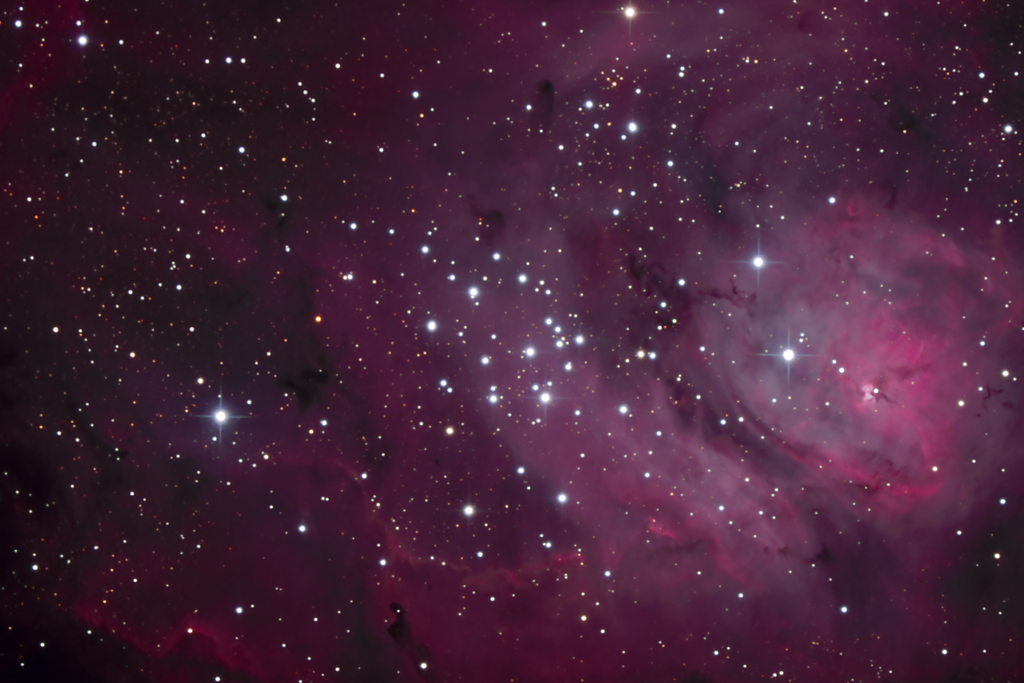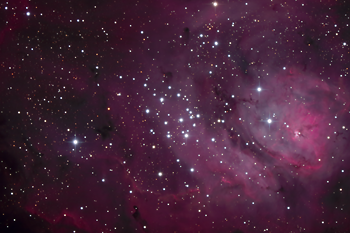 |
CHAMÄLEON + ONJALA OBSERVATORY DeepSky | SITEMAP HOME CHAMÄLEON |
|
 |
|||
| « back to overview Cluster | Load
higher resolution (1800 x 1200 Pixel 3500 x 2300
Pixel) |
Object description |

Our image shows the central region of the Lagoon Nebula with the open star cluster NGC 6530 and the two stars Sgr 9 and Herschel 36. The raw sum images were only exposed briefly for this image to prevent overexposure of the bright stars of the star cluster. In addition, this also avoided overexposure of the bright nebulae in which the star cluster is embedded.
The star cluster NGC 6530 contains about 50 to 100 stars, among them several blue giant stars of the spectral classes B and O. According to Shapley, it is considered a star cluster. According to Shapley, it is classified as class II 2 m n. Observations show that the stars of NGC 6530 are slightly in front of the actual Lagoon Nebula as seen from Earth. However, similar to the stars in the nebula's interior, the stars are surrounded by dust - showing a systematic reddening of the starlight, as is to be expected when light is scattered by tiny dust particles.
The stars of NGC 6530 were formed only a few million years ago from the nebular masses of the Lagoon Nebula. Today, the hot intense ultraviolet radiation from the blue giant stars ionises the hydrogen gas of the Lagoon Nebula and makes it shine brightly.
The distance of the Lagoon Nebula from the solar system is about 5,000 light years. New stars are constantly being formed in the nebula itself; the dark patches at various points in the nebula are huge clouds of gas and dark dust (glubules) that collapse under the influence of their own gravity, creating entire clusters of very young and brightly shining stars.
The star Herschel 36
In the optically brightest part of the nebula is a small region, about 4 light-years across, which is also called the "Hourglass Nebula" because of its appearance. It is considered the central region of the Lagoon Nebula. It is a turbulent star-forming region and it is excited and energised by the young star Herschel 36. It has spectral class O7 and is one of the youngest known stars, with an age of only about 10,000 years.
 |
Herschel 36 is a multiple star system, the main component has 30
times the mass of our Sun. Other such superstars are located in this region,
but are still hidden in dark clouds and are only visible in the infrared
spectral range. The star Sgr 9 The star Sgr 9 is the visually brightest star in the Lagoon Nebula, with just under the 6th magnitude class. With a spectral class of O4 it contributes significantly to the ionisation of the hydrogen gas of the Lagoon Nebula. Whether the star belongs to the star cluster NGC 6530 is unclear. A general overview of the region around the Lagoon Nebula in a mosaic is shown here. « Click here or on the thumbnail to load a large image with object names and size comparison to the moon. |
 |
 |
 |
 |
 |
 |
 |
| Sun | Moon | Solar System | DeepSky | Widefield | Miscellaneous | Spec. Projects |